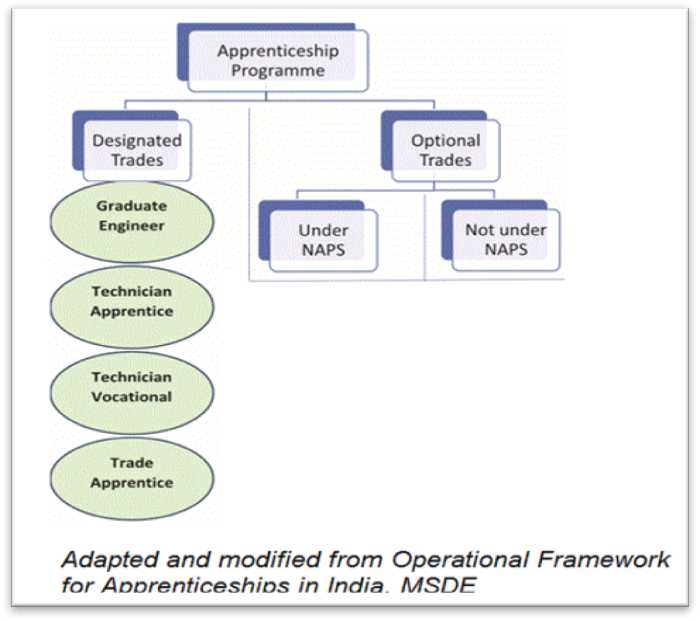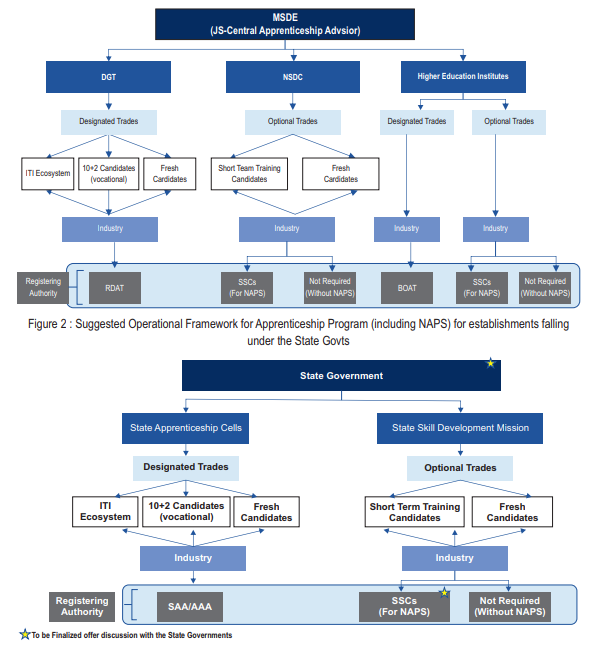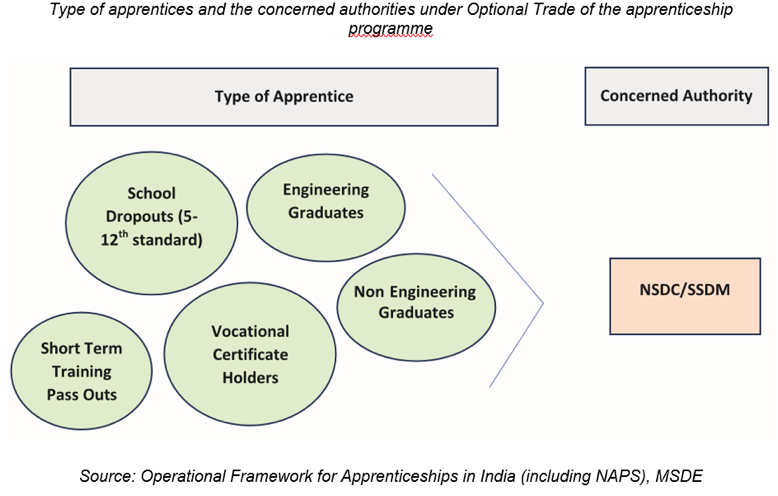You have figured out the advantages of an apprenticeship programme for your organisation. How do you go about starting one? What options, assistance and benefits does the government provide?
The types of apprentices, what they entail and the ministries responsible for their implementation can be a big blur given the various paths available and changes at different points of time. We have demystified and unravelled some of the key elements around apprenticeships in India to help your establishment embark on its apprenticeship journey.
What Are Your Options
Apprenticeship schemes offered by the government are under the purview of the Ministry of Skill Development and Entrepreneurship (MSDE) at the national level. There are five categories of apprentices namely; trade or designated trade apprentices, graduate apprentices, technician apprentices, technician(vocational) apprentices and optional trade apprentices.
These various categories fall under two schemes- the National Apprenticeship Training Scheme (NATS) within which sits the National Apprenticeship Promotion Scheme (NAPS).


Apprenticeship training under the two schemes comprise of basic training and on premise practical training at the workplace of an establishment. The basic training accounts for 20-30 percent of the total duration of the apprenticeship and forms an integral part of the training for those who have not previously had any skill training prior to embarking on an apprenticeship.
What is the Apprenticeship Framework?
Guidelines issued by the MSDE in February 2018 and May 2018 have put across a new implementation structure for administering the different apprenticeships available. Responsibility has been split as follows:
- Designated Trades or Trade Apprentices – Directorate General of Training (DGT) supported by the Regional Directorates of Apprenticeship Training (RDATs).
- Optional Trades- National Skill Development Corporation (NSDC) supported by Sector Skill Councils (SSC) and Industry Chambers.
- Graduate and Technician Apprentices- Ministry of HRD supported by four regional Boards of Apprenticeship Training (BOATs).
- State level NAPS for Optional Trades- State Skill Development missions (SSDMs) supported by SSCs and Industry chambers.
- State level Designated Trades or Trade Apprentices – State Apprenticeship Advisor (SAA).


What is the National Apprenticeship Training Scheme (NATS)
NATS is based on the Apprentice Act (1961) to impart vocational training to fresh graduates, diploma holders and 10+2 vocational pass-outs.
Apprenticeship Reforms
The Apprentice Act (1961) has undergone several amendments over the years to improve on clauses and mandates considered rigid and industry unfriendly. The most recent change in 2014 have brought about much more clarity and welcome changes based on recommendations from various stakeholders. In essence much more power has been shifted to employers. We capture the main points:
- A new category of ‘optional trade’ which is demand based, meaning any trade or occupation or any subject field in engineering or non-engineering or technology or any vocational course as may be determined by the employer for the purposes of this Act.


- Employers to determine qualification, period of apprenticeship training, holding of test, grant of certificate and other conditions relating to the apprentice in optional trade
- Employers free to decide the categories of apprentices and trade(s) based on needs and type of training facility available in their workplace.
- An employer may engage apprentices from other states
- Several employers may join together either themselves or through an agency, approved by the Apprenticeship Adviser
- Post apprenticeship training every employer shall formulate its own policy for permanent recruitment of an apprentice
- A thorny point of the previous versions of the Act was imprisonment for violations under the Act. After the amendment, any non-compliance would be punishable only with a fine.
Changes in the definition:
- ‘Trade apprentice’ is an apprentice undergoing training in any designated trade.
- ‘Designated trade’ means any trade or occupation or any subject in engineering or non-engineering or technology or any vocational course which the central government specifies as a designated trade for the purposes of the Act.
- Graduate or technician apprentice’ means an apprentice who holds, or is undergoing training in order that he may hold a degree or diploma in engineering or non-engineering or technology or equivalent qualification granted by any institution recognised by the government and undergoes apprenticeship training in any designated trade
- Term ‘worker’ has been broadened to include contractual and agency workers, working on the employer’s premises and employed either directly or through an agency, for wages.
- Industry’ means any industry or business in which any trade, occupation or subject field in engineering or non-engineering or technology or any vocational course may be specified as a designated trade or optional trade or both
What is the National Apprenticeship Promotion Scheme (NAPS)
To boost the NATS and incentivize more employers to join its mission on skill building the government launched the NAPS in 2016. NAPS has a tall ambition of training 5 million apprentices by 2022. NAPS covers all categories of apprentices except the Graduate, Technician and Technician (Vocational) apprentices which are administered by the Ministry of HRD.
What’s coming?
In Part II, we will cover the following heads.
- Your obligations and responsibilities
- Financial Assistance
- Certifications
- How do you start and when
References:
- Operational Framework for Apprenticeships in India (including NAPS), Ministry of Skill Development & Entrepreneurship
- NAPS Guidelines, Ministry of Skill Development & Entrepreneurship
- NCVT MIS – Frequently Asked Questions
- The Apprentices (Amendment) Act 2014- Ministry of Law and Justice- The Gazette of India
- National Apprenticeship Training Scheme
- National Apprenticeship Training Scheme- Designated Trades Portal
- National Apprenticeship Training Scheme- Optional Trades Portal














